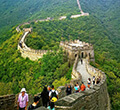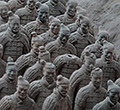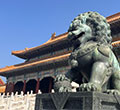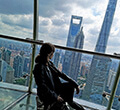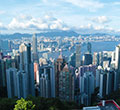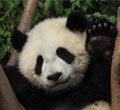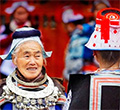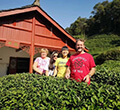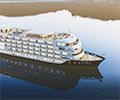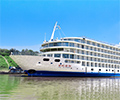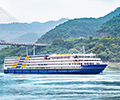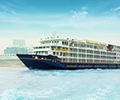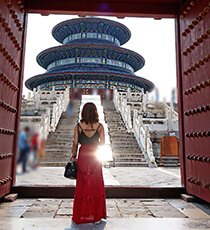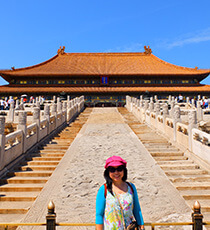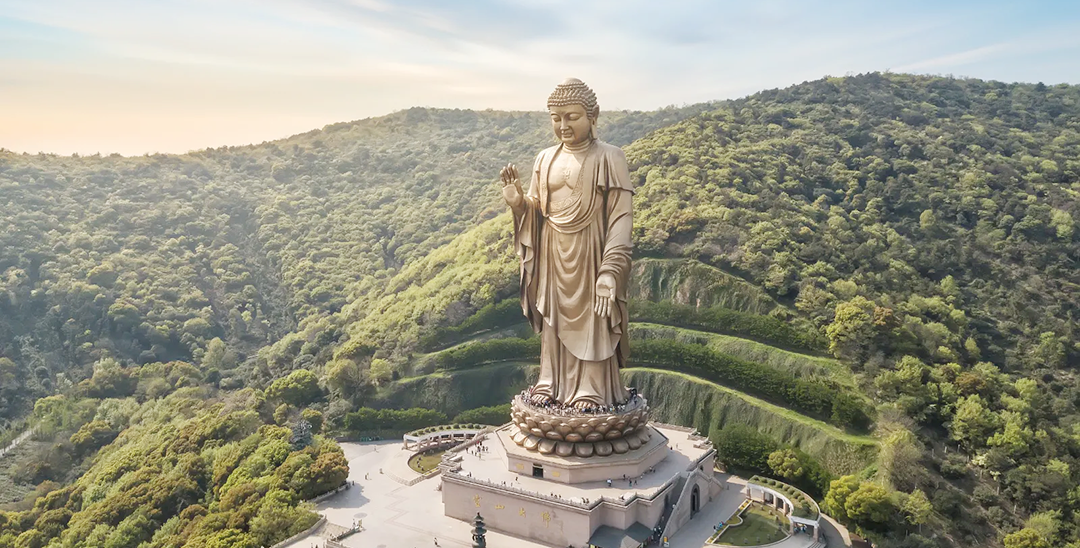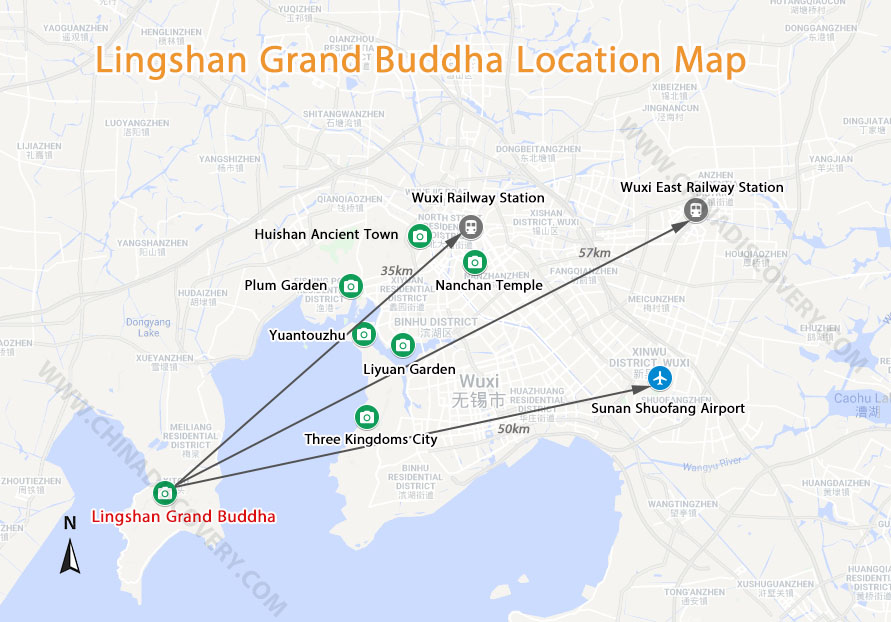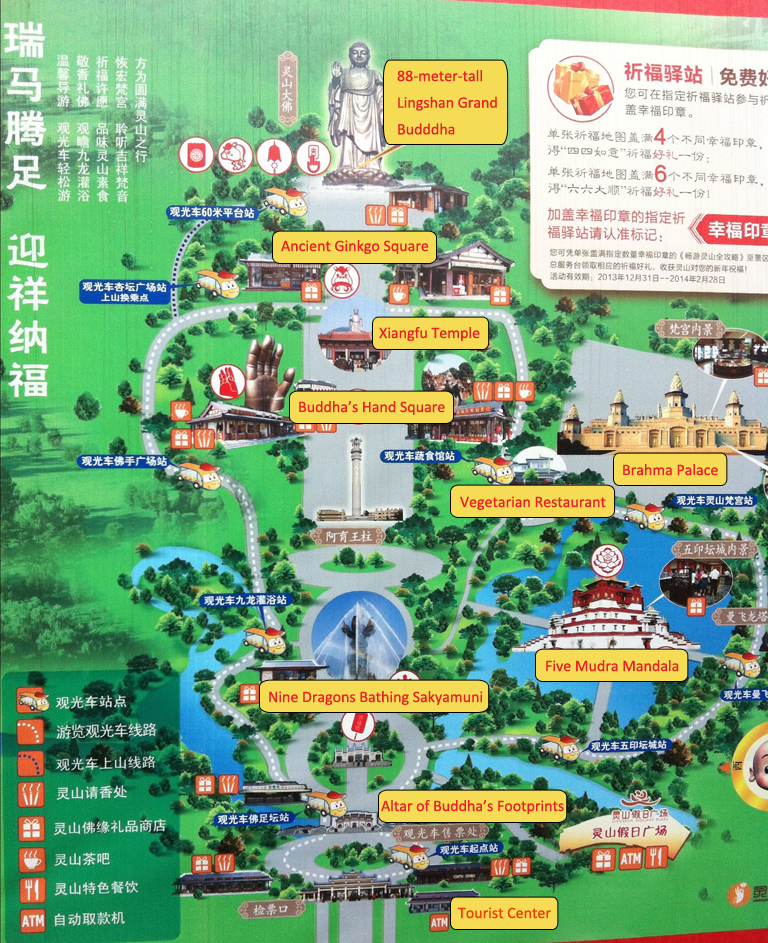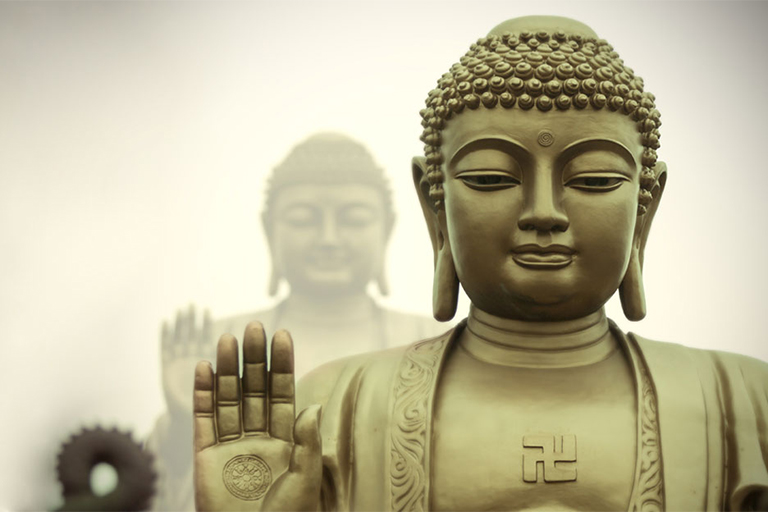Lingshan Grand Buddha - A Must-see in Wuxi City
Lingshan Giant Buddha or Lingshan Buddha, is one of the symbols of Wuxi City located at the northern bank of Taihu Lake. This holy land - Lingshan Grand Buddha Scenic Area gets its name because it is in “small Lingshan”, named by Xuanzang - a famous Chinese Buddhist monk in early Tang Dynasty (A.D. 618-907). Built in 1997, the bronze Shakyamuni Buddha at Lingshan stands majestically at 88 meters tall, among which the body of the Buddha is 79 meters and the lotus flower pedestal is 9 meters. Embraced by three hills and facing Taihu Lake, this great Buddha is friendly smiling, observing all livings and protecting his people.
Lingshan Grand Buddha’s construction was held by Zhao Puchu, the former chairman of the Buddhist Association of China. His inspiring idea “Five Great Buddhas in Five Orientations of China” has made great influence on the development of Chinese Buddhism. Now, you can see Wuxi Lingshan Grand Buddha in the east of China, Hong Kong Tian Tan Buddha in the south of China, Leshan Giant Buddha in the west of China, Yungang Grand Buddha in the north of China and Longmen Grand Buddha in the center of China. Actually, being the world’s tallest bronze Shakyamuni Buddha in the open air, Lingshan Grand Buddha is 17 meters taller than Leshan Giant Buddha in Sichuan Province.
Lingshan Grand Buddha is a must-see in a Wuxi tour. Below are some recommended Wuxi tour packages including Lingshan Grand Buddha:
☛ 2 Days Wuxi Highlights Tour
☛ 5 Days Charming Jiangsu Tour (Suzhou, Wuxi & Nanjing)
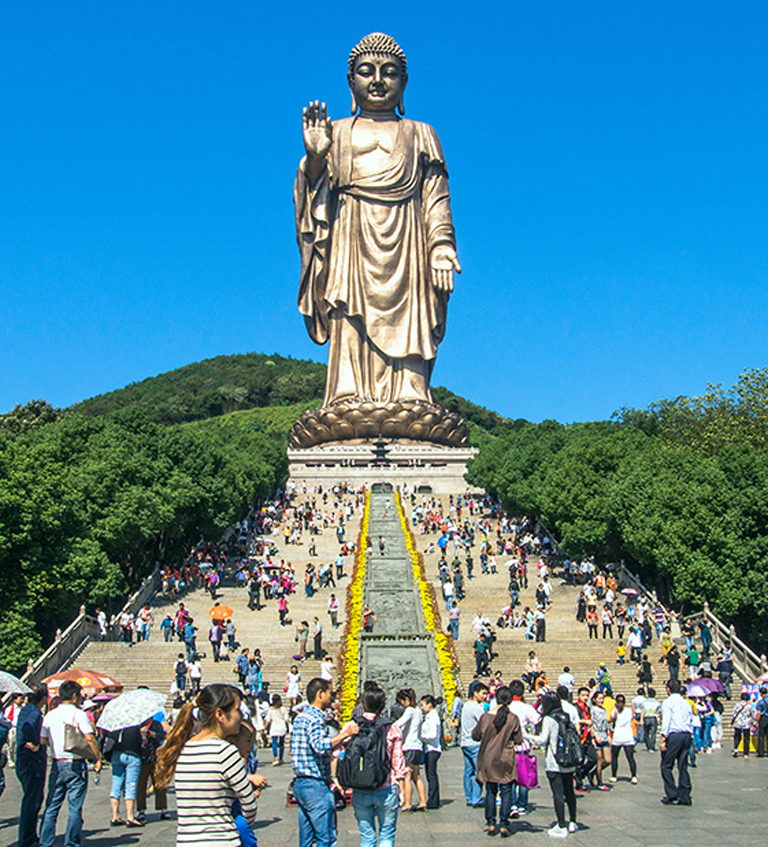 Magnificent Lingshan Grand Buddha
Magnificent Lingshan Grand Buddha
What to See in Lingshan Grand Buddha Scenic Area
The majority of the attractions sit along a southeast-northwest axis from the main gate to the Grand Buddha statue with some sights to the east. Besides the temples, statues and gardens, you can also attend some meaningful Buddhist performances.
Nine Dragons Bathing Shakyamuni (九龙灌浴)
According to the Buddhist classic Abhiniskramana-sutra, the Buddha Shakyamuni could speak and walk when he was born. A lotus grew and bloomed on every step he made when he walked seven steps in the four directions. Then, he pointed to the sky with one hand and pointed to the ground with the other hand and said “I am the honored lord of the world”. At that time, two pools appeared in the garden and nine dragons appeared in the sky spitting out water to bath Shakayamuni.
Travelers can enjoy the real scene of “Nine Dragon Bathing Shakyamuni” which does not only exist in the legendary story. With the Buddhist music starting, the six pieces of lotus flowers are blooming and the 7.2-meter-tall Golden Buddha is appearing with one hand pointing to the sky and the other pointing to the ground. The nine dragons are spitting out water for about 10 meters high to bath the sacred Buddha. Sometimes if weather permits, you can even see the rainbow over the water. Travelers can even taste the holy water outflowing from the mouths of phoenixes standing around the fountain. It is said that the holy water can bring luck and health to you.
Time to Enjoy Nine Dragons Bathing Shakyamuni: 10:00; 11:30; 14:45; 16:45.
Brahma Palace (灵山梵宫)
The Brahma Palace is situated at the foot of Lingshan Hill with magnificent architecture, harmonious layout, tall colonnade, soaring dome and large-scale hall. The architecture is an example to present profound Buddhism with a blend of traditional cultural elements and modern features. Entering inside the palace, travelers can appreciate the exquisite Dongyang woodcarving, elegant murals by Dunhuang skilled painters, grand oil paintings, quaint cloisonné Sumeru lamps and lots of art treasures scattered in Brahma Palace.
The inspiring performance called “Ode to Auspice” (吉祥颂) is held every day in the Altar of Brahma Palace. Time to Enjoy “Ode to Auspice”: 10:35; 11:30; 14:00 and 16:00 (Monday to Friday); 10:35; 11:30; 13:00; 14:00; 15:00 and 16:00 (Saturday and Sunday). Travelers should come 20 minutes ahead for checking in.
Five Mudra Mandala (五印坛城)
Gorgeous golden roof, huge gilding aquaria, striking prayer flags… This is the scene of Five Mudra Mandala with unique and original Tibetan architecture. It occupies 8000 square meters, like a standard football field. And it stands 31.55 meters tall with six stories. This is the well-known type of mandala - the mandala of the “Five Buddhas”, archetypal Buddha forms embodying various aspects of enlightenment. The “Five Wisdom Buddhas” are enshrined in five directions, including Rratnasambhava in the south (南方宝生佛), Amitabha in the west (西方阿弥陀佛), Amoghasiddhi Buddha in the north (北方不空成就佛) and Akshobhya in the east (东方阿閦佛) and Vairocana Buddha in the center (中央毗卢遮那佛). The inner decoration of Five Mudra Mandala is holy, pure and solemn with painted sculptures, mural, woodcarvings, Thangka, gold-platint, all presenting spectacular Mandala art.
Buddha’s Hand Square (佛手广场)
On the left side of Buddha’s Hand Square is the largest palm of Buddha in the world and on the right side of the square is a Maitreya Buddha with 100 children playing with him on his body.
Largest Buddha Hand in the World: The 11.7-meter high and 5.5-meter wide statue of the hand is a 1:1 replica of the right hand of the Grand Buddha of Lingshan. You can imagine how magnificent the Lingshan Buddha is. You can either observe or touch the big hand. This right hand is the “giving Abhaya Mudra” (施无畏印) which means to overcome suffering and make all living creatures free of fear. Buddha’s Hand in Chinese is “Foshou” (佛手) which is the homophonic phrase of “Fushou” (福寿 happiness and longevity). Visitors believe that touching this big hand will bring good fortune and longevity.
100 Children Playing with Maitreya Buddha: This 8.5-meter-long bronze Maitreya Buddha is always smiling with 100 children playing on his body. Some of them are making a human pyramid, some doing tug-of-war, some poking Buddha’s belly with tree branch, and some peeing on the body… The Maitreya Buddha does not mind what the children do on his body and he tolerates, forgives and loves all the children. He is always magnanimous, so he owns the true happiness.
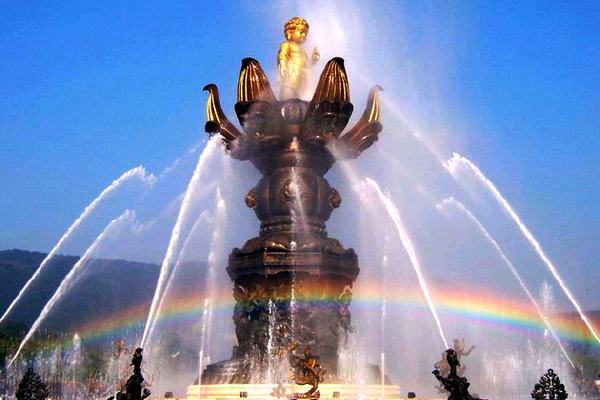 Nine Dragons Bathing Shakyamuni
Nine Dragons Bathing Shakyamuni
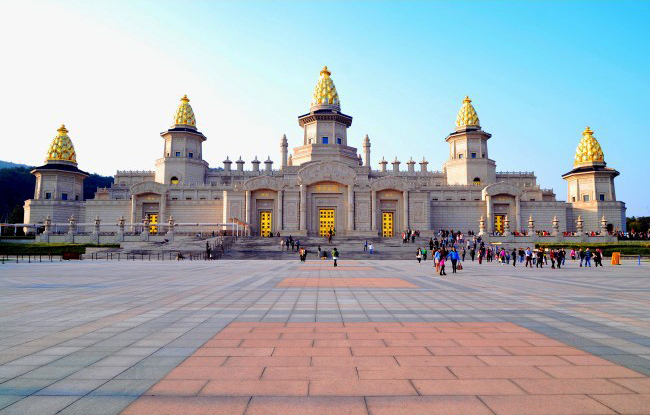 Brahma Palace Appearance
Brahma Palace Appearance
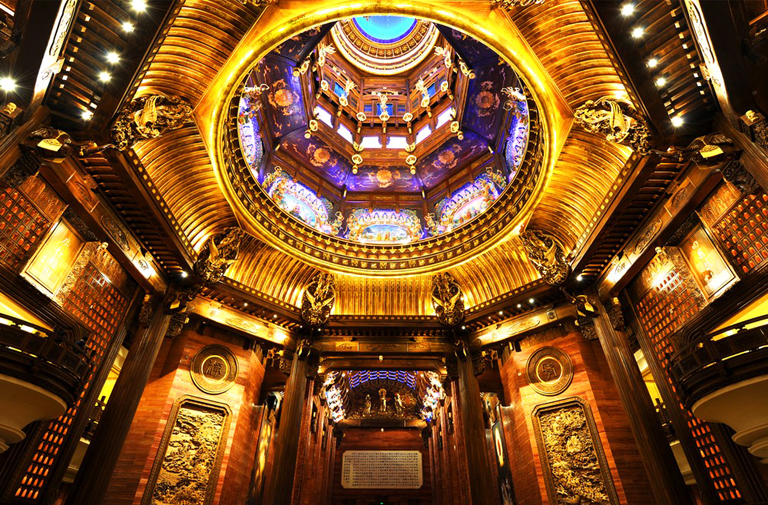 Exquisite Brahma Palace Decoration
Exquisite Brahma Palace Decoration
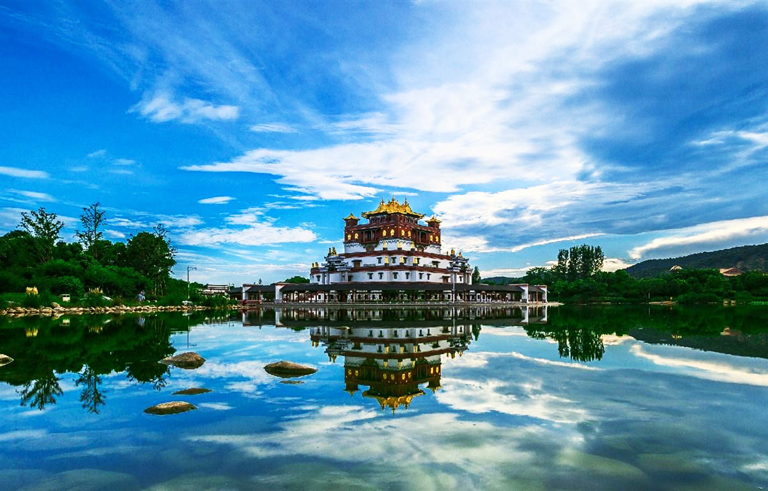 Five Mudra Mandala
Five Mudra Mandala
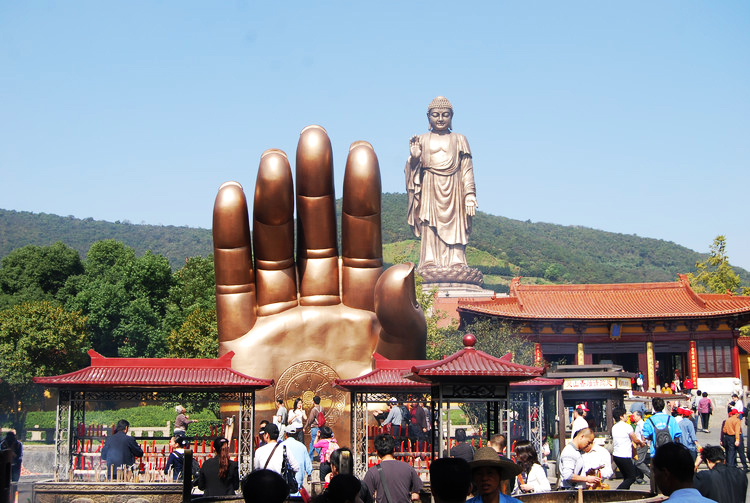 Largest Hand in the World
Largest Hand in the World
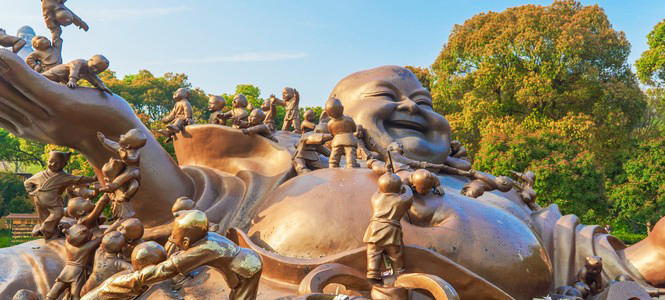 100 Children Playing with Maitreya Buddha
100 Children Playing with Maitreya Buddha
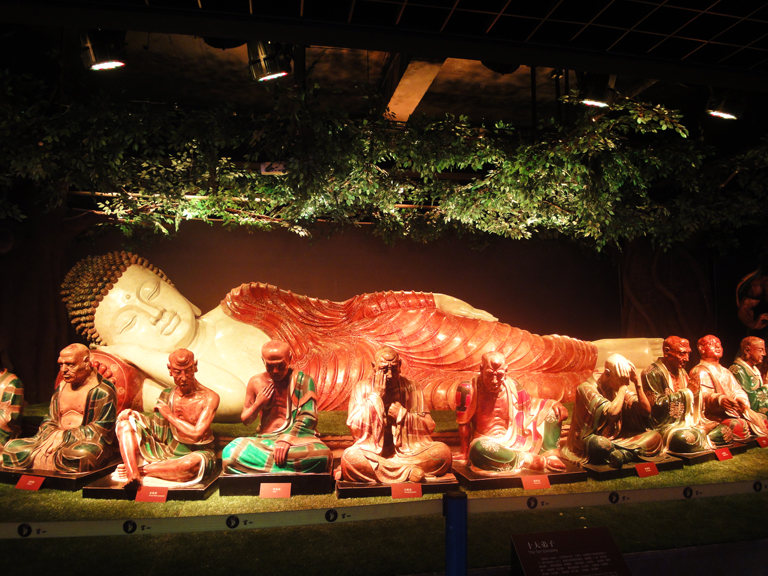 Buddhas in Lingshan Buddhist Culture Museum
Buddhas in Lingshan Buddhist Culture Museum
Map & How to Get to Lingshan Grand Buddha Scenic Area
Lingshan Buddha Scenic Area is located at the south side of Mashan Qinlu Peak, on the Majishan Peninsula stretching from the northern bank of Taihu Lake. It is about 50 km (1 hour’s drive) from Wuxi Sunan Shuofang International Airport, 35 km (about 45 minutes’ drive) from Wuxi Railway Station, 57 km (about 1 hour’s drive) from Wuxi East Railway Station. Usually, travelers who visit Lingshan Grand Buddha are from Shanghai, Suzhou, Nanjing or Hangzhou. The mentioned cities are connected with Wuxi by high speed train which is very convenient for transfer.
- Shanghai - Wuxi: 130 km, 2 hours by car, 30 minutes by high speed train. There are about 200 high speed trains from Shanghai Hongqiao Railway Station and Shanghai Railway Station to Wuxi Railway Station and Wuxi East Railway Station. Within 1.5 hours, you can get to Wuxi from Shanghai and the fastest trains need only about 30 minutes.
- Suzhou - Wuxi: 50 km, 1 hour by car, 10 minutes by high speed train. It is extremely convenient to travel from Suzhou to Wuxi. There are about 150 high speed trains a day and the fastest one takes only 10 minutes.
- Nanjing - Wuxi: 200 km, 2.5 hours by car, 1 hour by high speed train. There are over 100 high speed trains from Nanjing Railway Station or Nanjing South Railway Station to Wuxi Railway Station or Wuxi East Railway Station. It is the most recommended travel way.
- Hangzhou - Wuxi: 200 km, 3 hours by car, 1.5-2.5 hours by high speed train. There are about 20 high speed trains available every day from Hangzhou East Railway Station (a few from Hangzhou Railway Station) to Wuxi Railway Station or Wuxi East Railway Station.
Transportation in Lingshan Grand Buddha Scenic Area
Travelers can either walk or take sightseeing bus (CNY 30, Operating Hours: 08:45-16:30) to visit Lingshan Grand Buddha Scenic Area. If you take sightseeing bus, you can stop at Altar of Buddha’s Footprint, Nine Dragons Bathing Sakyamuni, Buddha’s Hand, Ancient Gingko Tree Square, Brahma Palace, and Five Mudra Mandala, etc.
Recommended Visiting Route
To save your energy and time, you can follow our recommended route to visit: Entrance → Grand Screen Wall → Altar of Buddha’s Footprints → Nine Dragons Bathing Sakyamuni → Buddha’s Hand Square → Xiangfu Temple → Ancient Ginkgo Square → Grand Buddha → Brahma Palace → Flying Dragon Tower → Five Mudra Mandala → Exit.
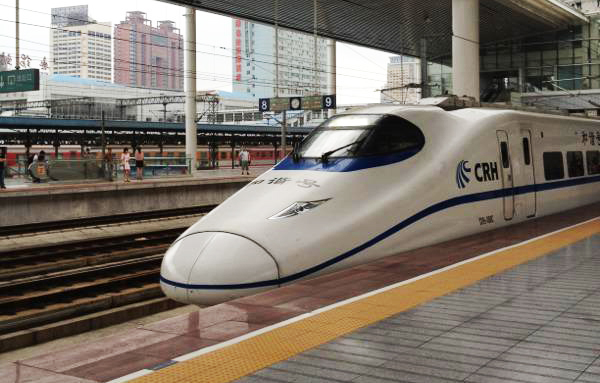 High Speed Train to Wuxi
High Speed Train to Wuxi
Travel with China Discovery (Recommended):
If you want to get rid of hustle of public transportation and troublesome navigation, you can book a private tour package which covers sightseeing, dining and transfer from us. Our local tour guide and driver will pick you up at the airport/train station/your hotel and then escort you to Lingshan Grand Buddha with speed and convenience. We will take care of all the details. You just need to focus on sightseeing. Contact us now >>
Useful Travel Tips
1. Elevator to Touch Lingshan Grand Buddha’s Feet
The elevator is set in the Lingshan Buddhist Culture Museum on the base of Lingshan Grand Buddha. The elevator will ascend you to the feet of the Grand Buddha and people believe that touching its feet will bring good fortune.
2. Show Respect to Buddha
In a religious scenic spot, tourists are supposed to respect the Buddha and Buddhist belief. Buddha statues in Xiangfu Temple are not allowed to take pictures.
3. Luggage Storage
The tourist center provides free luggage storage service from 07:00 to 17:00 from Monday to Sunday.
How to Plan Your Travel in Wuxi
How to Get to Wuxi: You can easily get to Wuxi by high speed train from Suzhou (0.5~1.5 hours), Nanjing (1 hour), Hangzhou (1.5~2.5 hours), Beijing (5.5 hours), Shanghai (0.5~1.5 hours), etc. as well as flight from Beijing (2.5 hrs), Xian (2 hrs), Chengdu (2.5 hrs), Guangzhou (2.5 hrs)...
Best Time to Visit Wuxi: Spring (March~ May) and autumn (September ~ November), especially spring when various flowers can be aprreciated
In order to explore the cultural and natural highlights of Wuxi, 2 days are needed generally. What you won’t miss are Lingshan Grand Buddha - an 88-meter-bronze Buddha statue and Yuantouzhu with Wuxi’s best scenic beauty. It is also recommended to visit Huishan Old Town to probe in to the historical ancestral halls and buildings, Jichang Garden to admire ingenuity of the classical gardens of south regions of the Yangtze River, Wuxi Old Street (Nanchang Street) along the old canal to feel traditional and modern atmosphere together. Besides, there are lots of gardens and wetlands located near Taihu Lake delivering an amazing natural vista to you.
If you want to explore more about Jiangsu Province, you can travel to Suzhou - the city of classical gardens and silk, Nanjing - an old capital of 6 dynasties, Yangzhou - old culture center of southern China, etc. Check more about Jiangsu Tours>
☛ 5 Days Jiangsu Tour (Suzhou, Wuxi & Nanjing)
If you have more days, you can expand your Wuxi trip to Shanghai - modernest metropolis in China, Hangzhou - home to picturesque West Lake, and Huangshan - magnificent Yellow Mountain and Hui-style ancient villages. Or you can contact us to customize a trip according to your own itinerary and interests. Just tell us your needs and we will take care of everything, you just need to focus on sightseeing!
☛ 3 Days Hangzhou & Suzhou Beauty Tour by High Speed Train
☛ 8 Days East China Tour by High-speed Train
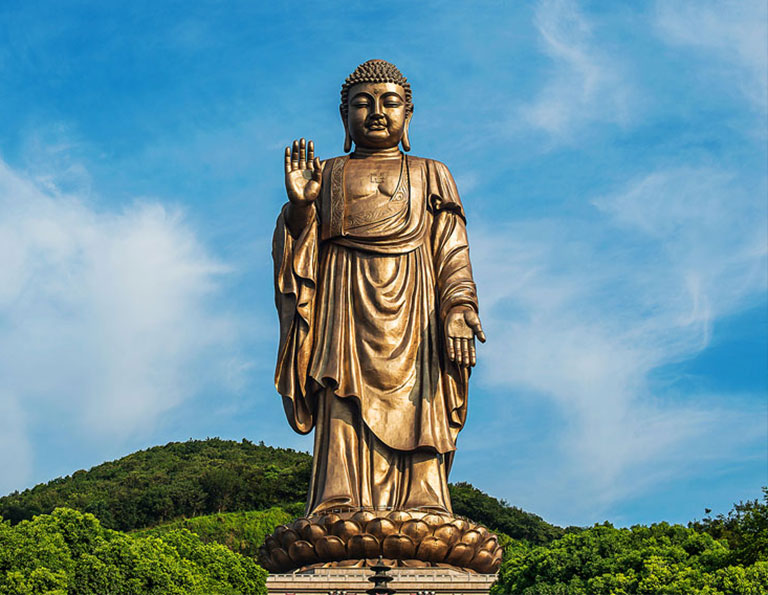 Lingshan Grand Buddha in Wuxi
Lingshan Grand Buddha in Wuxi
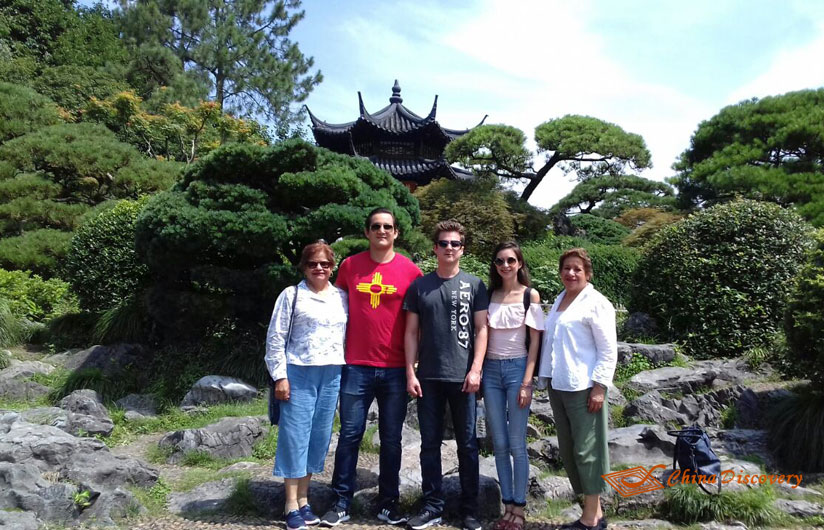 Our Customers visited Hangzhou
Our Customers visited Hangzhou
- Yuantouzhu
- Things to do & Top Attractions
- Get There & Around
- Weather & Seasons
- Accommodation
- Wuxi Maps
- More Wuxi Travel Guide
Wuxi Travel Guide
More about Jiangsu Travel Guide
Recommended Wuxi Tours
Top 3 Wuxi tours chosen by most customers to explore Wuxi in the best way. Check the detailed itinerary, or tailor your own trip now with us.

8 Days Diverse East China Yangtze Delta In-depth Tour
Shanghai / Suzhou / Nanjing / Hangzhou

5 Days Charming Jiangsu Tour (Suzhou, Wuxi & Nanjing)
Suzhou / Wuxi / Nanjing
Start planning your tailor-made holiday to China by contacting one of our specialists. Once inquired, you’ll get a response within 0.5~23.5 hours.
Customize a TripHave a question? Get answers from our travel experts or guests
- Your Question:
- Your Name:
- Your Email:
- Submit
